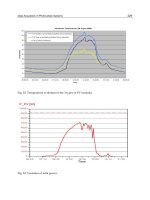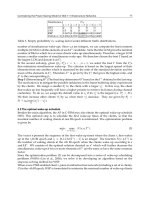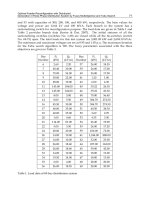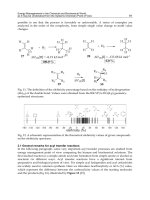Energy Technology and Management Part 6 potx
Bạn đang xem bản rút gọn của tài liệu. Xem và tải ngay bản đầy đủ của tài liệu tại đây (1.39 MB, 20 trang )
Energy Managements in the Chemical and Biochemical World,
as It may be Understood from the Systems Chemistry Point of View
91
possible to see that the process is favorable or unfavorable. A series of examples are
analyzed in the order of the complexity, from simple single value change to multi value
changes.
Fig. 11. The definition of the olefinicity percentage based on the enthalpy of hydrogenation
(ΔH
H2
) of the double bond. Values were obtained from the B3LYP/6-31G(d,p) geometry-
optimized structures.
Fig. 12. A schematic representation of the theoretical olefinicity values of given compounds
on the olefinicity spectrum.
3.1 General remarks for acyl transfer reactions
In the following paragraph, some very important acyl transfer processes are studied from
energy management point of view comparing the human and biochemical solutions. The
first studied reaction is a simple amide and ester formation from simple amine or alcohol as
reactants via different ways. Acyl transfer reactions have a significant interest from
preparative and biological points of view. For simple acyl halogenides and acyl anhydrides
are widely used in common synthesis. Here we introduce Δcarbonylicity or ΔCA (%) value,
which represent the difference between the carbonylicity values of the starting molecules
and the products (Eq. 16), illustrated by Figure 13 [13].
Energy Technology and Management
92
Fig. 13. A general acyl transfer reaction, where the active acyl reagent reacts with reactant Y,
producing acyl product and X.
ΔCA (%) = CA%(product) – CA%(starting material) (16)
If the resultant ΔCA value is positive, then the reaction is favored from the ‘carbonylicity
point of view’. Of course, a reaction may have several other parameters, which determine if
a reaction is favored or not, such as steric hindrance, kinetic consequences, side-reaction;
therefore a positive carbonylicity value does not mean automatically the occurance of a
reaction. Nevertheless, the Δcarbonylicity represents a thermodynamic driving force of an
acyl transfer reaction, analogously to the role of amidicity (AM%) in the case of the
transamidation reactions (Figure 14). The change in the amidicity value gives information
about the direction of a transamidation reaction, described by Eq. 17. In the following part,
this new methodology is applied on the field of peptide chemistry, especially for the peptide
bond formation [10].
Fig. 14. A general transamidation reaction, where the active amide reagent reacts with
amine reactant Y, producing amide product and X.
ΔAM (%) = AM%(product) – AM%(starting material) (17)
As was mentioned, amide and ester functionalities play crucial role in chemistry
constructing proteins, nucleic acids, polyhydrocarbons, vitamins, lipids, drugs, plastics and
many other important materials. The simplest chemical reagent to form amide or ester
bonds is carboxylic acides. However, carboxylic acids are typically not able to effectively
form the desired amide product and the ester formation is also very slow under normal
conditions. In this case the slow ester formation reaction can be explained by the low
carbonylicity change.
The unproductive amide formation in the case of carboxylic acids is due to the
deprotonation of the acid reagents to an unreactive reagent by the amine, being in an acid-
base equilibrium. Carboxylate anion exhibits very large carbonylicity value (106%), which
makes this reaction to very endothermic, consequently unsuccessful. From Figure 15 it is
Energy Managements in the Chemical and Biochemical World,
as It may be Understood from the Systems Chemistry Point of View
93
clear that in order to produce an ester or an amide the acid has to be activated or in other
word has to prepare a high energy reagent. One of the simplest protocols for activation is
the chlorine exchange of the hydroxyl group, but it can be done via different methods. The
first method for reagent formation of Figure 16 clearly indicates that the HCl molecule is not
energetic enough to carry out the necessary activation. In the second method of Figure 16,
where the high energy content phosphoryl chloride (POCl
3
) is already sufficiently strong for
activate the carboxylic acid. Finally, high energy active reagent, acid chloride can readily
react with ammonia in an exothermic reaction.
Fig. 15. Thermodynamics of simple ester and amide formation. Data were taken from the
National Institute of Standards and Technology (NIST).
3.1.1 Acyltransfer reactions making amide bonds
An amide or peptide bond can be formed by different ways and each method starts with the
activation of the acid reactant, followed by the nucleofil attack of the amine reactant. From
the carbonylicity point of view, the reaction between an acid (e.g. 31) and an amine (e.g. 34)
is thermodynamically advantageous, in the present example the reaction exhibit +3.9 % of
Δcarbonylicity, which means Δcarbonylicity / m = 3.9 / 0.4830 = 8.1 kJ/mol increase in
resonance energy. However, as was discussed before, an acid is not able to react with an
amine due to the high carbonylicity value of the forming inactive carboxylate anion in the
protonation-deprotonation equilibrium. To form amide 35, the acid reagent need to be
activated somewhat, that is to be transformed to a more active carbonyl reagent (36) having
lower carbonylicity value. In all of the activation methods, this high carbonylicity value of
31 are lowered significantly, consequently the reactivity of the acid is enhanced [10–12].
Energy Technology and Management
94
Fig. 16. Formation and utilization of an active (i.e. high energy) reagent. Data were taken
from the National Institute of Standards and Technology (NIST).
O
N
O
O
31
36
51.7 % 57.1 %
H
HN
O
X
X%
35
34
HN
34
No reaction
Activation
Reaction
Fig. 17. Amide formation through reactant activation
Five different activation methods are considered and studied here; involving acylchloride
(R-I), anhydride (R-II), active ester (R-III, R-IV, R-V). Also, activation by 1-hydroxy
benztriazole derivatives (BOP and HBTU, R-VI) and by dicyclohexyl carbodiimide (DCC, R-
V). The most widely known amide forming reagent is the acyl chloride (R-I; 37 in Figure 18)
exhibiting as low carbonylicity value as 23.7 %. In the course of reaction with an amine (34),
the change in carbonylicity is very significant (ΔCA = +33.4%), yielding 35 [10].
In the case of the peptide bond formation via mixed anhydrides (R-II), the acid (31) is
reacted by isobutyl-chlorophormate (38, in Figure 19), resulting a mixed anhydride (39) with
low carbonylicity value on the original carbonyl functionality (29.8 %). This active species
may easily react with an amine (34), leading to the desired product 35 (57.1 %) and side-
Energy Managements in the Chemical and Biochemical World,
as It may be Understood from the Systems Chemistry Point of View
95
product 40 (55.6 %), which decomposes to isobutylene, CO
2
and H
2
O. Although, in the
activation step (31 + 38 → 39) the change in the carbonylicity value is small, but negative but
small (–4.4 %), the HCl elimination and the salt formation with the applied base provide a
strong driving force. The active mixed anhydride reagent (39) exhibits low carbonylicity at
C2, indicating a significant reactivity toward 34, however C4 atom possesses a larger
carbonylicity, which is not so reactive, therefore only products 35 and 40 form exclusively
and not 41 and 42, which route is not preferred from either thermodynamic and kinetic
point of view [10].
Fig. 18. Amide formation through activated acid chloride
Fig. 19. Amide formation through activated mixed anhydride
Originally, an alkyl ester (43) is able to transform to the corresponding amide 35 and 44, but
due to the high carbonylicity value of the ester 43 and the small change in Δcarbonylicity in
R-III (Figure 20), the reaction requires usually high temperature or Lewis acid catalyst (e.g.
AlMe
3
) to proceed. Active esters, which are usually aryl esters, however exhibit lower
carbonylicity values, which allow a smooth reaction under convenient circumstances.
Energy Technology and Management
96
Fig. 20. Amide formation from various esters
In R-IV and R-III (Figure 20), two known coupling procedures are presented, which were
used earlier to prepare peptide bond. In both cases, the significant increase in the
carbonylicity values predicts a smooth reaction of the aryl ester (45, 47) with 34, resulting
amide 35, beside 46 and 48 as by-products [10].
However, these active esters proved to be not so efficient due to the relatively high reaction
temperature and long reaction time, which may be attributed to the not too significant
carbonylicity changes. More modern coupling reagents in the peptide chemistry, such as
benzotriazole-1-yl-oxy-tris-(dimethylamino)-phosphonium hexafluorophosphate (BOP, 49a,
R-VIa in Figure 21) and O-benzotriazole-N,N,N’,N’-tetramethyl-uronium-hexafluoro-
phosphate (HBTU, 49b, R-VIb) provide more rapid peptide bond formations in smooth
conditions. In both cases, in the first step, is the elimination of the 1-hydroxy-benztriazole
moiety (50) of the reagent, leading to a very active acylating agents 51a (25.5 %), 51b (28.3
%), which reacts with 50, forming a common, less active, but active enough intermediate 52
(36.4 %). Finally, this intermediate 52 takes part in an acyl-exchange reaction with 34,
furnishing the formulation of a new peptide bond in 35. Due to the higher carbonylicity
change during the reaction, the reaction rate is faster even at room temperature. Moreover,
the corresponding carbonylicity values for 51a, 51b during the reaction sequences may
explain the experimental observation that the BOP reagent (49a) is usually provide faster
reaction than HBTU (49b) [10].
The one of the most efficient peptide bond forming reagents is the N,N’-
dicylclohexylcarbodiimide (DCC, 53), which readily reacts with the carboxylic acid (e.g.
31),
forming a very active species 54 (38.7 %), as shown by R-VII in Figure 22. Subsequently, this
intermediate furnishes a reaction with amines (34), meanwhile N,N’-dicyclohexylurea (DCU,
55) leaves the molecule, yielding the amide 35.
The most impressive usage of DCC may well be the synthesis of penicillin (Figure 22, R-
VIII/a), where the last step of cyclization was carried out using this reagent. According to
literature data, this cyclization of the open chain mono-deprotonated penicillin derivative
(56) was successful only in basic condition (aqueous KOH). After the reaction between 56
Energy Managements in the Chemical and Biochemical World,
as It may be Understood from the Systems Chemistry Point of View
97
and DCC (53), the carbonylicity value 51.7 % decreases dramatically to 36.0 %, in the
resulting intermediate 57. Due to the slightly higher carbonylicity value of the penicillin
product 58 (37.1 %), is the reason that intermediate 57 can in fact cyclize to form penicillin
58. However, this small, but positive difference in the carbonylicity (37.1 % – 36.0 % = + 1.1
%) is not sufficient to provide enough driving force to complete the reaction, therefore the
experimental yield is rather low (10–12%) [10].
Many unsuccessful experiments were carried out in order to cyclize penicillin in neutral or
slightly more acidic conditions in the hope to improve the yield (Figure 22, R-VIII/b).
In this
case, the starting compound is in neutral form (59), which reacts with DCC, furnishing
intermediate 60 (carbonyilicity value = 36.0 %), having the same value, than it was obtained
for 57. However, here the penicillin product is neutral (61), which exhibits much lower
carbonylicity value (22.6 %), therefore the reaction is unable to proceed, due to the negative
Δcarbonylicity value (22.6 % – 36.0 % = –13.4 %) [10].
In the triglyceride synthesis (R-IX in Figure 23) the starting fatty or oleic acid forms (62) an
ester bond with a glycerin or its derivative (67). Living organism follow an analogue
strategy as the human synthesis, namely acid (62) is activated by ATP (63) in the form of
phosphorous anhydride (64), when the carbonylicity value of the carbonyl group is decrease
to as low as 37.1%. This already active species presumably is in a too active form, it can
hydrolyze in the aqueous media rapidly, therefore it is transformed to a somewhat
stabilized reagent by means of CoA (65), yielding a little bit more stable a tioester derivative
of fatty acid (66). This fatty acid derivative, finally can enter in an acyl transfer reaction by
glycerine, providing the final product as glycerine ester 68 [10].
Fig. 21. Amide formation through carboxylic acid activation using 1-hydroxy-benztriazole
derivative
Energy Technology and Management
98
O
N
O
O
31
54
51.7 %
55.6 %
R
-VII
O
O
H
HN
35
38.7 %
CN
N
c-Hex
c-Hex
N
N
H
N
O
N
H H
c-Hexc-Hex
-
58
51.7 %
R-VIII/a
56 37.1 %
CN
N
c-Hex
c-Hex
N
N
H
N
O
N
H H
c-Hexc-Hex
-
N
S
O
O
O
H
N
R
N
S
O
O
O
HN
R
HO
H
N
S
O
O
O
HN
R
H
36.0 %
57
53
55
34
53
55
CA = 16.9 %
61
51.7 %
R-VIII/b
59
22.6 %
CN
N
c-Hex
c-Hex
N
N
H
N
O
N
H H
c-Hexc-Hex
-
N
S
O
OH
O
H
N
R
N
S
O
OH
O
HN
R
HO
H
N
S
O
OH
O
HN
R
H
36.0 %
60
53
55
CA = 1.1 %
CA = -13.4 %
Fig. 22. Amide formation from carboxylic acid through activation by DCC
Fig. 23. Tri-gliceride formation from fatty acides via thioester activation.
From chemical point of view, the in vivo peptide or protein synthesis is based on similar
strategy (R-X in Figure 24), where the free amino acid (69) is activated via analogous
phosphorylation process (69 → 70) by means of ATP (63), resulting primary active reagent
70, which reacts with a hydroxyl group on a well-defined site of tRNS (71), stabilizing the
Energy Managements in the Chemical and Biochemical World,
as It may be Understood from the Systems Chemistry Point of View
99
active species in a less, but still active ester from (72). This AA-tRNS is the main active
intermediate in this process, resulting finally the polypeptide chain (74) [10].
Fig. 24.
3.1.2 Transamidation reactions
The amide bond may be considered as one of the most important chemical building blocks,
playing an important role not only in living organisms, but in organic chemistry as well.
Amide bonds may be considered as a one of the most important chemical moieties in
biological organisms, common in peptides/proteins and lipids/membranes and other
biochemical systems. Amides also play an important role in selected biologically active
compounds, such as Penicillin-like antibiotics, drugs and toxins. They are characterised as
being very stable chemical bonds, with half-lives in neutral aqueous solution exceeding
hundreds of years.
In contrast to their general resistant to reactivity, there are numerous examples in the field of
organic and biochemistry, where the amide bond undergoes nucleophilic reaction.
Examples include the spontaneous or enzymatic hydrolysis of amide bond in peptides,
proteins. Perhaps the most famous small biogen amides are the Penicillin-like antibiotics,
which inhibit penicillin binding proteins such as transpeptidase and carboxylpeptidase
through an acylation of a serine residue. In this way, the bacterial cell wall synthesis stops,
leading to higher susceptibility to osmotic effect and cell burst.
The reduction of the amide bond by complex metal hydrides has significant synthetic
importance to obtain various amines. Some amide compounds are able to react with amines,
called as an acyl transfer or transamidation reaction. These processes represent very useful
transformations in synthetic organic chemistry to obtain various amide structures from amino
compounds, selectively. The most notable application is the Traube synthesis of heterocycles.
In many biological or pharmaceutical cases, Mother Nature or the practicing chemist must
find the appropriate balance between the reactivity and stability of the amide bond. If the
amide bond is too reactive, it may have an increased activity, but may also be metabolised
prior to reaching its intended target (the enzyme). If however, the amide bond is less
reactive, with an increased stability in aqueous solutions and bodily fluids, it will be
difficult for such a compound to react with efficacy when it encounters the target (the
enzyme). The Penicilin-like antibiotics
5
presents a good example for the above mentioned
natural design; the β-lactam ring is highly reactive due to its strained four-membered ring,
which may open easily in the presence of nucleophilic reagents, such as the hydroxyl group
Energy Technology and Management
100
of an enzyme side-chain. The reactivity of the amide bond can be fine-tuned by using
different substituents, obtaining an appropriate molecule, which survives the aqueous body
fluid and finds the targeted enzyme.
Unsubstituted amides such as 75 and 33 exhibit a reduced value of amidicity (Figure 21)
relative to mono-substituted or di-substituted ones, such as 77 and 35 (97–103 %); one may
therefore predict a transamidation proceeding between them. Mono- and di-substituted
amines (e.g. 34) are shown to react readily with formamide (75, R–XI) and acetamide (35, R–
XII) at RT or above, as used in the Traube synthesis. The formylation of benzylamine and N-
methylbenzylamine furnished by 75 proceeded very smoothly, however, in the case of 33,
AlCl
3
was required in order to attain an acceptable rate, which is due to the high activation
energy of the sterically hindered reaction center [10–12].
Fig. 21. Examples for transamidation involving secondary amine.
Compounds 78 and 82 represent mild acylating agents (Figure 22) taking part in
transamidation reactions with amines (e.g. 79 for R-XIII and R-XIV), forming amide 81 and
80 and 83 as side-products. The acylating properties of these compounds can be attributed
to the competition between the aromatic ring and the amide group of the N atom lone pair,
which decreases both the amidicity and aromaticity percentages of the 78 and 82. The main
driving force of these reactions is the significant increase of the amidicity value during the
acylation reaction. Compound 84 in R-XV (Figure 22) exhibits an extremely low amidicity
percentage (–30.2 %), making this molecule an excellent acylating agent, prepared in situ
from AcCl and pyridine. Thus, 84 readily reacts with amines (e.g. 85 for R-XV), with an
extremely large ΔAM value (Figure 22) even at low temperature. In R-XVI, the acetanilide
derivatives (e.g. 88) with lowered amidicity values are also shown to be acylating
compounds, transferring their acyl group to alkyl amines (e.g. 34 in Figure 22). The not too
high ΔAM value may be one of the underlying reasons that these types of reactions are not
often referred to in the literature. The reaction between 88 and 34 is very slow, even in the
presence of AlCl
3
at high temperature, but it may be due to the larger steric hindrance of the
carbonyl group in 82 [10–12].
Energy Managements in the Chemical and Biochemical World,
as It may be Understood from the Systems Chemistry Point of View
101
Fig. 22. Example for transamidation involving cyclic secondary amines
Using amidicity values, one may explain the inactivity of some commonly used organic
amide-type solvents, such as N,N-dimethylformamide (77, DMF, R–XVII in Figure 23) and
N-methylpirrolydinone (91, NMP, R–XVII, Figure 23). In both cases the ΔAM values are
negative, making the reaction ‘amidically unfavorable’, therefore no reaction can be
observed between 77 or 91 with 85 or 34, even at 180º and in the presence of AlCl
3
as catalyst
[10–12].
Fig. 23. Attempted transamidation reactions involving fully substituted amides and
secondary amines
The use of the amidicity change or the change in stabilization enthalpy leads to a
thermodynamic selection rule, allowing for the reactions to be categorized as being either
thermodynamically favorable or unfavorable. This principle was illustrated as being
operative in cases of differing reactions. Such a thermodynamic selection rule may be used
to predict the selectivity of reactions in the presence of competing functional groups. The
selectivity of the transamidation reactions was applied to molecular systems having an
Energy Technology and Management
102
additional, but another type of amino group (93). Molecule 93 has two opportunities for
acylation, where in principle it could have yielded two types of mono-amide compounds
(94–95 and 96–97) or a single diamide compound (98 or 99) as represented in Figure 24. As
the amidicity change (ΔAM) indicated, only the alkyl amine group could react with 75 and
33, therefore only compounds 94 and 95 were formed, whereas 96 and 97 as well as 98 and
99 were not produced, even in traces amounts [10–12].
Fig. 24. Selectivity of transamidation reactions
From the numerous biochemical processes, involving transamidation reaction, only few, but
very representative examples are presented here. The first example is taken from the
multistep process of the blood clotting. In the last thirteenth step (R-XX in Figure 25) of the
process, the two final protein intermediates 100 and 101 are jointed to each other through
forming a side-chain amide bond. This process is spontaneous, therefore does not require
external energy input. From system chemistry point of view, it is due to the positive ΔAM
value of the process, where the initial 96.0% is increased to 101%. This small change
provides a driving force for this reaction, but it is not enough to exhibit high reaction rate,
therefore it is catalyzed by an enzyme transamidinaze [21].
Fig. 25.
Energy Managements in the Chemical and Biochemical World,
as It may be Understood from the Systems Chemistry Point of View
103
The intein-mediated protein splicing (R-XXI) is, relatively speaking, a newly discovered
biological process (Figure 26) [21]. In this case however two amides are involved in
transamidation process rather than me amide and one amine as before. Protein splicing is so
rapid that the precursor protein is rarely observed in native systems. The intein peptide
sequence usually contains no sufficient information and it is supposed to be originated from
a virus, which inserted into the original DNA sequence producing the protein. The original
broken protein sequence is named as extein. The intein plus the first C-extein residue
contain sufficient information for splicing in foreign proteins, which involves four basic
chemical steps. For the sake of simplicity, here we have presented only the starting and the
ending states of the reaction and the amidicity values of the amide bonds were calculated
for the functional groups in question.
Fig. 26. Protein splicing as a special type of transamidation reaction.
The overall process exhibits large negative ΔAM value (–45 %), which may result an
endothermic reaction. However, the folding of the spliced protein supposed to be more
favorable, than that of the original, intein containing protein, which may provide an other
driving force covering the energy demand of the overall process.
3.2 Complex analysis: Comparison of redox reactions of NAD and FAD with human
made redox reaction [18]
Biochemical reactions are exceptionally energy-efficient relative to laboratory synthetic
processes. Liberation and subsequent loss of heat in exothermic reactions (e.g. redox
processes) is a mismanagement of energy and would be biologically detrimental as are
highly endothermic ones, thus are avoided in nature. To support such a hypothesis,
laboratory redox reactions were compared to those occurring in biological organisms.
Evidently, Nature is able to store reactive potential within the molecular system, in carefully
designed chemical structures which act as reversible energy carriers; effectively molecular
free-energy capacitors. This modus operandi of Nature implies that during the evolutionary
process, only those molecular that fulfilled near thermo-neutral requirements were retained.
In an oxygen-containing atmosphere the development of aerobic life required appropriate
reducing/oxidising agents. Thus, long ago Nature implemented the coenzymes
dinucleotides Nicotinamide Adenine Dinucleotide (NAD
+
, 106) and Flavin Adenine
Dinucleotide (FAD, 107; for full structures see Figure 27, where the R groups later are
Energy Technology and Management
104
simplified to Me) together with their respective redox pairs NADH and FADH
2
to mediate
the redox processes in all known living cells. These bioreagents play crucial energy storage
roles, which act as ‘energy catalysts’, storing reductive potential until required.
N
NH
2
O
R
N
NH
2
O
R
N
N
N
N
O
O
H
N
H
N
N
N
O
O
H
H
R=
PO
O
O P
O
OH
O
OH
O
OH
HO
O
OH
O
N
N
N
N
NH
2
+
[H
2
]
+[H
2
]
+
H
3
O
+
Z
FAD Z = H
NAD
+
Z=H
NADP
+
Z=PO
3
H
2
H
2
O
+
HO
OH
HO
R
HO
OH
HO
R
NADH Z = H
NADPH Z = PO
3
H
2
FADH
2
Z=H
111
113
112 114
Fig. 27. The complete structures and reactions of NAD
+
(111) and FAD (112). The
apostrophises at the compound numbers are emphasizing that these are the full structures
rather than the model compounds on which the computations were performed.
These typical examples were selected, due to their published enthalpy of formation data.
The preparation of reagent H
2
requires high amount of external energy (enthalpy), usually
via electrolysis (R-XXII/a in Figure 28), while the reduction of pyruvate (108) to lactate (109)
releases or waste also the same order of magnitude enthalpy (c.a. –200 kJ/mol; R-XXII/b in
Figure 28). Other human applied reductive reagents, like NaBH
4
also serves analogues
examples, where both the preparation and the usage of these reagents are not very energy
efficient.
In the Nature side, the same reduction of pyruvate (108) to lactate (109) by using NADH
(108) as bioreagent wastes only c.a. 30 kJ/mol enthalpy (R-XXIII/b in Figure 28). Moreover,
the preparation of this active reducing reagent NADH (108) from NAD
+
(111) by means of
maleate (110) and oxalacetate (111) redox equilibrium (R-XXIII/a in Figure 28).
Comparing these human- (R-XXII) and bioprocesses (R-XXIII), both the preparation (a) and
reaction (b) of the NADH (bio)reagent proceed with 1/10
th
the enthalpy change observed in
the laboratory exercise, consequently this bioprocess can avoid the large endo- and
exothermic changes in the course of the reaction, does not requiring intense external heating
or cooling of the living organism. Such systemic chemical principles may be universally
applied in all life-related processes. Coupling between components of a chemically or
biologically important molecule, such as aromatic rings, amide groups, olefins, carbonyls
and metal-ligands, are central to the molecules’ chemical efficiency.
The reduction of NAD
+
and FAD is complimented by an enthalpy transfer between organic
functional components (aromatic ring, amide and olefinic functionalities), yet, the sum of
the overall energy values (the total system) remains nearly constant irrespective of what
direction the redox reaction proceeds. From this aspect, both NAD
+
and FAD operate as real
chemical systems of atoms and functional groups, working together within the individual
molecules to store the reaction enthalpy as resonance enthalpy, rather than manifesting it as
emitted or absorbed heat. In this way, the thermo-neutral reaction of the wet combustion
occurring in all living cells is made possible by an internal “cooling process”.
Energy Managements in the Chemical and Biochemical World,
as It may be Understood from the Systems Chemistry Point of View
105
Concerning NAD
+
(106) and FAD (107), two questions may be phrased: (Q1) What is the
role of the amide functionality and why the meta-substituted NAD
+
structure was selected
during molecular evolution? (Q2) Why a complex, three-ring structure is necessary for
proper function and catalytic efficacy of the FAD molecular system? A systemic approach is
required to answer these. Making use of the recently established methodology
15-19
,
hydrogenation reactions were used to determine aromaticity, amidicity and olefinicity
values.
Fig. 28. A schematic depiction of the order of magnitude difference in energetic efficiency
between synthetic and natural processes. The preparation of the reducing agents [I/a and
II/a] and redox processes [I/b and II/b] in the case of a certain, biologically significant
reaction are used as examples.
3.2.1 NAD Coenzyme and its models
From the Systems Chemistry point of view, many organic molecules are comprised of
aromatic, amidic and olefinic portions, linked together by the global electronic structure of
the system. These organic functional groups may easily be described by the concept of
‘conjugativicity’; a term analogous to aromaticity,
15
amidicity,
16,17
carbonylicity
18
and
olefinicity.
19
Accordingly, the structure of NAD
+
and related models I–III (106, 112, 114, 116)
are composed of an aromatic (pyridine) and most of them an amidic part; each described
using aromaticity and amidicity parameters, respectively. The structure of NADH and its
related models I–III (107, 113, 115, 117) are composed of one amidic and two olefinic parts,
described by one amidicity and two olefinicity parameters, respectively.
Figure 29 provides a comparison of resonance enthalpy (RH) change in the naturally
occurring nicotinic amide (NAD
+
, 106) as well as its model congeners [models I (112), II (114
Energy Technology and Management
106
and III (116)]. Table 2 shows the naturally occurring meta isomer having the greatest RH
‘benefit’ (+42.5 kJ mol
–1
), manifested as an exothermic –42.5 kJ mol
–1
reaction enthalpy. Our
novel Systems Chemistry analysis shows that the principle RH component, originally stored
as aromaticity (145.8 kJ mol
–1
) in the pyridine ring of NAD
+
(106), is partly transferred post-
reduction (106 → 108), to the two olefinicities a and b.
Systems Chemistry
aromaticity amidicity olefinicity
% kJ/mol % kJ/mol % kJ/mol kJ/mol
Natural 106
95.1
145.8
35.2
28.1
0.0
0.0
form 108
0.0
0.0
109.0
86.7
34.6+54.4
129.5
+145.8
–58.7
–129.5 –42.5
112
91.6
140.8
36.4
29.0
0.0
0.0
Model I 113
0.0
0.0
103.7
86.7
36.1+32.1
97.6.5
+140.8
–53.5
–97.6 –10.6
114
101.0
154.8
66.1
52.6
0.0
0.0
Model II 115
0.0
0.0
98.2
78.1
38.1+38.1
109.0
+154.8
–25.5
109.0 +20.2
116
94.9
145.5
0.0
0.0
0.0
0.0
Model III 117
0.0
0.0
0.0
0.0
32.6+32.6
93.4
+145.5
0.0
–93.4 +52.1
Table 2. Summary of different “icity” values (aromaticity, amidicity and olefinicity) and
related resonance energies in kJ/mol calculated for 106,108, 112–117. For details see Figure
29.
This resulted in 16.8 kJ mol
–1
less than complete energy recovery. However, the change in
amidicity of the amide functionality provides 58.7 kJ mol
–1
to RH, covering not only the
‘missing’ 16.8 kJ mol
–1
, but also makes the overall process 42.5 kJ mol
-1
advantageous from
an RH point of view. In comparison, both the ortho (model I, 112 → 113) and para (model II,
114 → 115) isomers of NAD
+
are not able to provide overall RH ‘recovery’ (Table 2, Figure
29) during the reduction ; the principle reason that the natural form 106 uses the meta isomer
of NAD
+
as a part of this redox system. Not only is the meta position the most suitable, it
holds the most biologically available functional group, supporting the notion of ‘molecular
selection’ being operative during the evolution of redox biochemistry of all life.
Our study also indicated that the entire amide functionality is crucial from the Systems
Chemistry point of view, as the structurally simpler model III (117, Table 2, Figure 29)
cannot recover the loss of RH from the loss of aromaticity during the reduction (116 → 117),
due to the lack of an electron withdrawing group (EWG) in the meta position. The
biologically more prevalent COOH functionality, mostly existing as COO
–
at biological pH
6–8 (COO
–
is an electron donating group, or EDG), would be far less effective than the
CONH
2
EWG. Due to the highly effective energy recovery in both the forward and reverse
reactions, is the principle reason that the NAD
+
/NADH redox pair (106/108) works as a
near-thermoneutral bio-reagent in biochemeical reactions.
Energy Managements in the Chemical and Biochemical World,
as It may be Understood from the Systems Chemistry Point of View
107
Fig. 29. LEFT: Redox reactions of the natural form of NAD
+
and related pyrimidium ion
congener model systems (106, 112, 114, 116) and their respective reduced products (108, 113,
115, 117), including percentages of conjugative aromaticity (red), amidicity (blue) and
olefinicity (green) values. RIGHT: Changes in resonance enthalpy (RH) values related to
conjugativity, indicated by arrows using the same colour scheme as used at left, including
both the sign and magnitude of change.
3.2.2 Systems chemistry analysis of FAD
Analogously, the three ring FAD (107) and FADH
2
(109) can be dissected to an aromatic
portion composed of two rings (A and B) in addition to two-amide bond forming ring C,
accounted for by a combined aromaticity value and two amidicity parameters, respectively.
In this study some modified models of FAD–FADH
2
system are also considered as 118–119;
120–121 and 122–123. It may be demonstrated that all components of the FAD system (112)
(tricyclic form with ring A, B and C, involving two amide bonds; a and b; see Figure 30 and
Table 3) are essential. Thus such natural arrangement of functional groups is requisite for
proper function. From the Systems Chemistry point of view, FAD (107) may be considered
as being similar to NAD
+
(106). The oxidized form (108) is comprised of two fused-rings in
Energy Technology and Management
108
the aromatic portion (ring A and B), characterized by a single 131.2 % aromaticity value
(RH = 201.2 kJ mol
–1
). The aromatic component is connected to a 3
rd
ring, itself substituted
by two amide bonds having 111.6 % and 71.0 % amidicity values (RH = 88.7 kJ mol
–1
and
56.4 kJ mol
–1
), respectively (first line of Figure 30 and Table 3). The aromaticity in the
double-ring of the reduced form (109) is lowered to 100.9 % (RH = 154.7 kJ mol
–1
), while
amidicity rises in both amide bonds to 140.1 % and 125.4 %, respectively (RH = 111.9 kJ mol
–
1
and 99.7 kJ mol
–1
). Loss of aromaticity upon reduction (107 + H
2
→ 109), is rationalized by
an observed antiaromatisation of ring B (6 electron pairs in rings A and B), manifested as a
bent, non-planar, 3D fused-ring structure (109). However, amidicity values increase
significantly, resulting in an overall RH change of +20.1 kJ mol
–1
, representing a relatively
large exothermic change (–20.1 kJ mol
–1
) in the systemic RH.
The aromatic ring A of the FAD system serves to buffer the antiaromatisation of ring B,
appearing as a non-planar 3D structure of 107 and 118. This is exemplified on reduction of
FAD model I (118 → 119; second line Figure 30 and Table 3), wherein ring A is removed,
resulting in a corresponding Δaromaticity = –72.9 % in contrast to the –30.3 % change in the
natural form.
Systems Chemistry
aromaticity amidicity (a) amidicty (b)
% kJ/mol % kJ/mol % kJ/mol kJ/mol
Natural 107
131.2
201.1
111.6
89.1
71.0
56.7
form 109
100.9
154.7
140.1
111.8
125.4
100.1
+46.5
–23.3
–43.3 –20.1
118
41.2
63.2
111.4
88.9
72.4
57.8
Model I 119
–31.7
–48.6
144.8
115.6
126.4
100.9
+111.9
–26.6
–42.9 +42.4
120
126.2
193.5
122.2
97.6
59.2
47.3
Model II 121
111.5
170.9
111.2
88.8
49.7
39.7
+22.5
+8.8
+7.6 +38.8
122
124.7
191.2
51.5
41.2
0.0
0.0
Model III 123
103.2
158.2
80.0
63.9
0.0
0.0
Natural
+32.9
–22.7
0.0 +10.3
Table 3. Summary of different “icity” values (aromaticity, amidicity and olefinicity) and
related resonance energies in kJ/mol calculated for 107,109, 118–123. For details see Figure 30.
This is due to the large degree of antiaromaticity in the heterocycle component of 119
(aromaticity = –31.7 %), which is not offset by a corresponding, stabilizing increase in
amidicity; Δamidicity for 118 → 119 is similar to that of the 107 → 109 and the overall RH for
the reduction of model I is no longer favorable (+42.4 kJ mol
–1
).
The b amide component also serves a crucial systemic role, helping stabilize the system
upon reduction through a 54.4% amidicity increase in the natural form (107 → 109; 71.0 % →
125.4 %). Its removal (FAD model II (120); third line in Figure 30 and Table 3) ‘softens’ the
destabilizing reduction of aromaticity (120 → 121; 124.7 % → 103.2 % = -21.5%) relative to
the natural process (107 → 109 = -30.3%). However, the absence of this secondary –CONH–
functionality excludes its thermodynamically advantageous amidicity increase, resulting in
an overall unfavorable process (120 → 121 = +10.3 kJ mol
–1
).
Energy Managements in the Chemical and Biochemical World,
as It may be Understood from the Systems Chemistry Point of View
109
The role of the chemical linkage between ring II and amide B was also examined using the
truncated FAD model III (122 → 123; fourth row in Figure 30). Removal of the bond
destroys ring C and raises the overall RH, making reduction +58.9 kJ mol
–1
less favorable
relative to the natural system, due to the absence of amidicity increase in amide II. In the
natural compound (107), ring C buffers the appearing antiaromaticity, manifested in its own
increased aromaticity and amidicity values (109). Truncation of this very important bond
eliminates the systemic linkage between ring B and amide b. In the reduction of FAD, only
the ring B and amide a components take chemical part in the reaction, together receiving
two electrons and two protons. One may therefore conclude that the role of all other
Fig. 30. LEFT: Redox reactions of the natural form of FAD (107) and their different models
(I, 118; II, 120 and III, 122) leading to reduced products (109, 119, 121, 123) and their
percentages of their respective conjugative [aromaticity (red), amidicity (blue)] values.
RIGTH: Changes of resonance enthalpy (RH) values related to conjugativity [indicated by
arrows with the same color as was used left, referring to both the sign and the amount of
these]. FAD (107) and its models 118, 120, 122 as well as FADH
2
(109) together with its
congeners (119, 121, 123) is composed of an aromatic ring (aromaticity, ring A and B) and
two amide functionalities (amidicity, amide a and b).
Energy Technology and Management
110
functional components is systemic, compensating for (reducing) the antiaromatization of
ring B. This leads to the thought that, were Nature truly so efficient, it would remove the
antiaromatization and the need for other components; unless antiaromatization itself were
essential, playing a secondary role in the process. Considering only the reductive part
of FAD (model III, 122, last line in Figure 30 and Table 3), removes the need to compensate
the disadvantageous antiaromaticity. The reductive power of the resultant small molecule
(122 → 123) is extremely large, meaning that by means of specialized enzymes, it has the
ability to reduce each reducable compound in the cell. However the associated large
exothermic reaction enthalpy would call for an intensive cooling process to bring the
temperature under control; antiaromaticity providing the ‘counterbalance’ to the process
and a means by which energy may be stored.
4. References
[1] Z. Mucsi, A. Szabo, I. Hermecz, Á. Kucsman, I.G. Csizmadia, J.Am. Chem Soc. 2005, 127,
7615–7631.
[2] E. Buncel, R.A.Stairs, H. Wilson, In The Role of the Solvent in Chemical Reactions; Oxford
University Press: Oxford, 2003.
[2] M. Nonn, L. Kiss, E. Forró, Z. Mucsi, F. Fülöp Tetrahedron, 2011, 67. 4079-4085.
[3] F. Ruff, I.G. Csizmadia, In Organic Reactions: Equilibria, Kinetics and Mechanism; Elsevier:
Amsterdam, 1994; Chapter 8. pp 232–239.
[4] J.C. Cramer, In Essentials of Computational Chemistry; John Wiley Sons Ltd.: West Sussex,
2001; Chapter 7. p 433.
[5] E. Frank, Z. Mucsi, I. Zupkó, B. Réthy, G. Falkay, Gy. Schneider, J. Wölfling, J. Am.
Chem. Soc.
2009, 131, 3894–3904.
[6] Z. Mucsi, B. Viskolcz, I. G. Csizmadia, J. Phys. Chem. A. 2007, 111, 1123–1132.
[7] Z. Mucsi, T. Körtvélyesi, B. Viskolcz, I. G. Csizmadia, T. Novák, G. Keglevich, Eur. J. Org.
Chem. 2007, 1759–1767.
[8] Z. Mucsi, I. Hermecz, B. Viskolcz, I. G. Csizmadia, G. Keglevich Tetrahedron, 2008, 64,
1868–1878.
[9] Z. Mucsi, G. Keglevich Eur. J. Org. Chem. 2007, 1759–1767.
[10] Z. Mucsi, A. Tsai, M. Szori, G. A. Chass, B. Viskolcz, I. G. Csizmadia, J. Phys. Chem. A.
2007, 111, 13245–13254.
[11] T. R. Varga, P. Nemes, Z. Mucsi, P. Scheiber Tetrahedron Letters, 2007, 48, 1159–1161.
[12] Z. Mucsi, G. A. Chass, I. G. Csizmadia, J. Phys. Chem. B. 2008, 112, 7885–7893.
[13] Z. Mucsi, G. A. Chass, B. Viskolcz, I. G. Csizmadia, J. Phys. Chem. A. 2008, 112, 9153–
9165.
[14] M. Porcs-Makkay, B. Volk, Z. Mucsi, Gy. Simig Tetrahedron, 2010, 66. 7017–7027.
[15] Z. Mucsi, G. A. Chass, B. Viskolcz, I. G. Csizmadia, J. Phys. Chem. A. 2009, 113, 7953–7962.
[16] M. Pilipecz, Z. Mucsi, T. Varga, P. Scheiber, P. Nemes, Tetrahedron 2008, 64, 5545–5550.
[17] T. Novák, Z. Mucsi, B. Balázs, L. Keresztély, G. Blaskó, M. Nyerges, Synlett, 2010, 16,
2411–2414.
[18] Z. Mucsi, G. A. Chass, I. G. Csizmadia, J. Phys. Chem. B. 2009, 113, 10308–10314.
[19] Z. Mucsi, I.G. Csizmadia, Current Organic Chemistry 2008, 12, 83–96.
[20] J. M. Berg,
J. L. Tymoczko,
L. Stryer, In Biochemistry, 5th edition; Freeman and Company,
New York, 2002.
[21] Y. Anraku, R. Mizutani, Y. Satow, IUBMB Life 2005, 57, 563–574.









